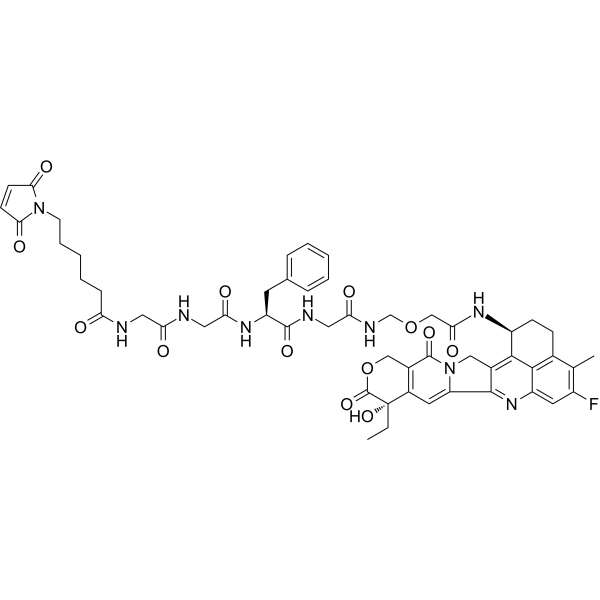
Deruxtecan
CAS No. 1599440-13-7
Deruxtecan ( —— )
产品货号. M26662 CAS No. 1599440-13-7
Deruxtecan 是一种 ADC 药物连接物缀合物,由 DX-8951 (DXd) 衍生物和马来酰亚胺-GGFG 肽连接物组成,用于合成 DS-8201 和 U3-1402。
纯度: >98% (HPLC)
 COA
COA
 Datasheet
Datasheet
 HNMR
HNMR
 HPLC
HPLC
 MSDS
MSDS
 Handing Instructions
Handing Instructions
| 规格 | 价格/人民币 | 库存 | 数量 |
| 5MG | ¥3062 | 有现货 |


|
| 10MG | ¥4026 | 有现货 |


|
| 25MG | ¥6116 | 有现货 |


|
| 100MG | 获取报价 | 有现货 |


|
| 200MG | 获取报价 | 有现货 |


|
| 500MG | 获取报价 | 有现货 |


|
| 1G | 获取报价 | 有现货 |


|
生物学信息
-
产品名称Deruxtecan
-
注意事项本公司产品仅用于科研实验,不得用于人体或动物的临床与诊断
-
产品简述Deruxtecan 是一种 ADC 药物连接物缀合物,由 DX-8951 (DXd) 衍生物和马来酰亚胺-GGFG 肽连接物组成,用于合成 DS-8201 和 U3-1402。
-
产品描述Deruxtecan is an ADC drug-linker conjugate composed of a derivative of DX-8951 (DXd) and a maleimide-GGFG peptide linker, used for synthesizing DS-8201 and U3-1402.(In Vitro):Antibody-drug conjugates deliver anticancer agents selectively and efficiently to tumor tissue and have significant antitumor efficacy with a wide therapeutic window.
-
体外实验Antibody-drug conjugates deliver anticancer agents selectively and efficiently to tumor tissue and have significant antitumor efficacy with a wide therapeutic window.
-
体内实验——
-
同义词——
-
通路Others
-
靶点Other Targets
-
受体E3 Ligase
-
研究领域——
-
适应症——
化学信息
-
CAS Number1599440-13-7
-
分子量1034.068
-
分子式C52H56FN9O13
-
纯度>98% (HPLC)
-
溶解度In Vitro:?DMSO : 35 mg/mL (33.85 mM)
-
SMILESCC[C@@]1(O)C(=O)OCc2c1cc1-c3nc4cc(F)c(C)c5CC[C@H](NC(=O)COCNC(=O)CNC(=O)[C@H](Cc6ccccc6)NC(=O)CNC(=O)CNC(=O)CCCCCN6C(=O)C=CC6=O)c(c3Cn1c2=O)c45
-
化学全称——
运输与储存
-
储存条件(-20℃)
-
运输条件With Ice Pack
-
稳定性≥ 2 years
参考文献
1.Boscaro C, et al. Non-genomic mechanisms in the estrogen regulation of glycolytic protein levels in endothelial cells. FASEB J. 2020 Sep;34(9):12768-12784.
产品手册




关联产品
-
12-Propanediol
丙二醇是一种丙二醇,由丙烷组成,其中 1 和 2 位的氢被羟基取代,通常用作药物赋形剂
-
Traxanox
Traxanox is an orally available diuretic.Traxanox enhances phagocytosis of yeast granules by mouse peritoneal macrophages or rat peritoneal polymorphonuclear leukocytes in vitro.Restorative effect of Traxanox on inhibition of antibody production in BALB/c mice.
-
Filanesib
Filanesib 是一种选择性驱动蛋白纺锤体蛋白抑制剂 (KSP, IC50 = 6 nM),具有有效的抗增殖活性。



 021-51111890
021-51111890 购物车()
购物车()
 sales@molnova.cn
sales@molnova.cn







